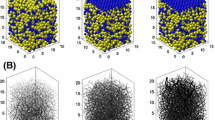Abstract
New comparisons of percolation and effective-medium theories on one hand, and predictions from the crowding factor on the other hand, are described for calculating critical concentrations in suspensions of cellulose fibres. The connectivity threshold from percolation theory appears to correspond to the “gel crowding factor”, which occurs at crowding factor (N) of N = 16 rather the criterion for fibre collisions, N = 1, postulated in earlier work. The rigidity threshold from percolation theory corresponds to the onset of coherent fibre flocs having mechanical network strength, which occurs at about N = 60. The latter value exceeds the gel crowding factor value by a factor of 3.75. In comparison, percolation theory predicts that flocculation occurs at a rigidity concentration four times higher than the connectivity threshold. These ratios are in good agreement.


Similar content being viewed by others
References
Celzard A, Deleuze C, Dufort M, Furdin G, Marêché JF, McRae E (1996) On the critical concentration in percolating systems containing a high aspect ratio filler. Phys Rev B 53:6209–6214. doi:https://doi.org/10.1103/PhysRevB.53.6209
Celzard A, Marêché JF, Furdin G, Puricelli S (2000) Electrical conductivity of anisotropic expanded graphite-based monoliths. J Phys D Appl Phys 33:1556–1563. doi:https://doi.org/10.1088/0022-3727/33/12/318
Celzard A, Krzesiñska M, Marêché JF, Puricelli S (2001) Scalar and vectorial percolation in compressed expanded graphite. Physica A 294:283–294. doi:https://doi.org/10.1016/S0378-4371(01)00038-3
Celzard A, Marêché JF, Furdin G (2005a) Modelling of exfoliated graphite. Prog Mater Sci 50:93–179. doi:https://doi.org/10.1016/j.pmatsci.2004.01.001
Celzard A, Treusch O, Marêché JF, Wegener G (2005b) Electrical and elastic properties of new monolithic wood-based carbon materials. J Mater Sci 40:63–70. doi:https://doi.org/10.1007/s10853-005-5688-z
Celzard A, Fierro V, Pizzi A (2008a) Flocculation of cellulose fibre suspensions: the contribution of percolation and effective-medium theories. Cellulose 15:803–814. doi:https://doi.org/10.1007/s10570-008-9229-1
Celzard A, Pizzi A, Fierro V (2008b) Physical gelation of water-borne thermosetting resins by percolation theory—urea-formaldehyde, melamine-urea-formaldehyde, and melamine-formaldehyde resins. J Polym Sci B Pol Phys 46:971–978. doi:https://doi.org/10.1002/polb.21433
Keep GT, Pecora R (1985) Re-evaluation of the dynamic model for rotational diffusion of thin, rigid rods in semidilute solution. Macromolecules 18:1167–1173. doi:https://doi.org/10.1021/ma00148a022
Kerekes RJ (2006) Rheology of fibre suspensions in papermaking: an overview of recent research. Nordic Pulp Pap Res J 21:598–612. doi:https://doi.org/10.3183/NPPRJ-2006-21-05-p598-612
Kerekes RJ, Schell CJ (1992) Characterization of fiber flocculation regimes by a crowding factor. J Pulp Pap Sci 18:J32–J38
Landau LD, Lifshitz EM (1980) Electrodynamics of continuous media. Pergamon, New York
Landauer R (1978) Electrical transport and optical properties of inhomogeneous media. In: Garland JC, Tanner DB (eds) AIP Conf Proc No 40. American Institute of Physics, New-York, pp 2–43
Martinez DM, Buckley K, Lindstrom A, Thiruvengadaswamy R, Olson JA, Ruth TJ, Kerekes RJ (2001) Characterizing the mobility of papermaking fibres during sedimentation. The Science of Papermaking 12th Fundamental Research Symposium. The Pulp and Paper Fundamental Research Society, Oxford, pp 25–254
Martinez DM, Kiiskinen H, Ahlman AK, Kerekes RJ (2003) On the mobility of flowing papermaking suspensions and its relationship to formation. J Pulp Pap Sci 29:341–347
Mason SG (1954) Fibre motions and flocculation. Tappi J 37:494–501
Soszynski RM, Kerekes RJ (1988) Elastic interlocking of nylon fibres suspended in liquid. Nordic Pulp Pap Res J 4:172–179. doi:https://doi.org/10.3183/NPPRJ-1988-03-04-p172-179
Stauffer D (1985) Introduction to percolation theory. Taylor & Francis, London
Author information
Authors and Affiliations
Corresponding author
Rights and permissions
About this article
Cite this article
Celzard, A., Fierro, V. & Kerekes, R. Flocculation of cellulose fibres: new comparison of crowding factor with percolation and effective-medium theories. Cellulose 16, 983–987 (2009). https://doi.org/10.1007/s10570-009-9314-0
Received:
Accepted:
Published:
Issue Date:
DOI: https://doi.org/10.1007/s10570-009-9314-0



